What I'm Reading: January 2022, with Commentary
January 19, 2022 at 7:06 PM
Here are the books, with Commentary, I’ve read and most admired in recent months,
June 2021–December 2021.
- Home Made: A Story of Grief, Groceries, Showing Up—And What We Make When We Make Dinner by Liz Hauck, memoir
- How the Word is Passed: A Reckoning with the History of Slavery Across America by Clint Smith, nonfiction, biography
- Memorial Drive: A Daughter’s Memoir by Natasha Trethewey
- The Wild Silence by Raynor Winn, memoir
- The Salt Path by Raynor Winn, memoir
- The Arsonist’s City by Hala Alyan, fiction
- The Giver of Stars by Jojo Moyes, fiction
- Inside Out and Back Again by Thanhha Lai, prose poem
- Everyday Vitality: Turning Stress Into Strength by Samantha Boardman, MD, guidebook
- The Book of Delights by Ross Gay, essays
- Other Words for Home by Jasmine Warga, prose poem story
- The Sisters of Auschwitz by Roxane Van Iperen, nonfiction story of resistance
- The Book of Joy: Lasting Happiness in a Changing World by His Holiness the Dalai Lama and Archbishop Desmond Tutu with Douglas Abrams, conversation
- Finding Freedom: A Cook’s Story Remaking a Life from Scratch by Erin French, memoir
- There is Nothing for You Here: Finding Opportunity in the 21st Century by Fiona Hill, memoir, history
- Being Perfect by Anna Quindlen, advice, wisdom
- A Swim in a Pond in the Rain—In Which Four Russians Give a Master Class on Writing, Reading, and Life by George Saunders, short stories and essays
- Why Are We Still Doing That? Positive Alternatives to Problematic Teaching Practices by Persida Himmele and William Himmele, professional
- Oh William! by Elizabeth Strout, fiction
- Rooted in Strength: Using Translanguaging to Grow Multilingual Readers and Writers by Cecelia M. Espinosa and Laura Ascenzi-Moreno, professional
- The 5 Languages of Appreciation in the Workplace: Empowering Organizations by Encouraging People by Gary Chapman and Paul White, professional
- These Precious Days by Ann Patchett, essays
- Intentional From the Start: Guiding Emergent Readers in Small Groups by Carolyn Helmas and Susan Vincent, professional
- A Ghost in the Throat by Doireann Ní Ghríofa, nonfiction, biography, memoir, poetry, prose
- The Archive of Alternative Endings by Lindsey Drager, fiction
While I highly recommend all the books on the list, I want to call out the texts that left the strongest impressions--those books that most impacted and informed me as a reader, writer, learner, thinker, and citizen. Because several of these titles combine nonfiction with fiction, and/or create their own original genre/form, I have not organized them into fiction and nonfiction categories, as has been my usual habit. My favorite reads follow.
- How the Word is Passed by Clint Smith is a must-read book for all of us concerned with understanding the history-- and having an honest reckoning-- of slavery in America.
- The Salt Path and The Wild Silence by Raynor Winn are gorgeous, unforgettable, connected memoirs that will change how you think about homelessness, nature, generosity, and living a good life.
- A Swim in a Pond in the Rain—in Which Four Russians Give a Master Class on Writing by George Saunders is a remarkable, genre-breaking text by one of America’s finest writers.
- For fans of Elizabeth Strout (I am one of them), Oh William! is the latest in her fictional series centering on Lucy Barton.
- These Precious Days by Ann Patchett, a book of personal essays, is the author at her finest and is a great way to start the New Year or any time of year.
- Also, although I have only just begun The 1619 Project created by Nikole Hannah-Jones and The New York Times Magazine, this book begs to be included now because of its monumental, historical significance for dealing with our country’s legacy of slavery.
- Finally, A Ghost in the Throat by Doireann Ní Ghríofa and The Archive of Alternative Endings by Lindsey Drager are extraordinary and surprising form-breaking books that are part of my “Commentary: The Impact of a Lovely, Local Independent Book Store—and More” at the end of this post.
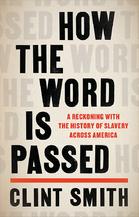
I devoured How the Word is Passed by Clint Smith, a brilliant and award-winning book that through careful scholarship and personal reflection helps us understand our fraught history with slavery. Smith takes us with him on his personal tour of former, key plantations and historic sites across America where he interviews local historians, guides, tourists, teachers, ex-convicts--all in an effort to attempt to understand and reckon with America’s complicated and tortured legacy of slavery and the way that story has been told. Since it is those with the power whose stories typically dominate what we hear and know, Smith is asking a crucial question: “How do you tell a story that has been told the wrong way for so long?” (p. 83). Some of the places he visits to get an intimate and clarifying look at our nation’s history of slavery include Thomas Jefferson’s Monticello; the site of Juneteenth in Galveston, Texas; the African Burial Ground in lower Manhattan, New York; Angola, the Louisiana State Penitentiary, and a Confederate cemetery. Among other factors, I was surprised to learn for the first time that New York City (in the North) had a large slave market, second only to the slave market in New Orleans (in the South.) What makes this book so important, unique, and a great read is the way Smith interviews and talks with people on this journey, “. . .managing to catch nearly everyone in a moment of unscripted candor. His ease with strangers is charmingly apparent.” “. . . He wonders, “Can a place that misstates a certain set of facts still be a site of memory for a larger truth?” (The New York Times Book Review). In How the Word is Passed, Smith goes out of his way to present a fair and balanced portrayal of slavery in America-- including the rare, successful counterpoints-- so that an open-minded reader comes away with a more accurate version of “the truth.”
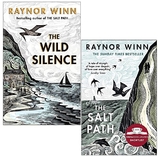 I adored Raynor Winn’s exquisitely written, unforgettable memoirs, The Wild Silence and The Salt Path. If you are older or are “an old soul” or have endured hardships, and love Nature, then you will be smitten too. I first heard about Raynor Winn’s The Wild Silence in The New York Times Book Review, which piqued my interest. While The Wild Silence continues the story of The Salt Path, the author herself notes you can read these memoirs out of order, as I did, and be perfectly fine with it all. The essence of the stories is that Winn and her husband Moth, a middle-class and middle-aged couple, find themselves suddenly homeless—unexpectedly evicted from a farm and house they had loved and tended. At the same time, Moth is diagnosed with an incurable brain cancer and given a short time to live. Nonetheless, with no resources or livelihood, they refuse to be defeated. With the barest of essentials, they harness Nature, courage, and grit in their decision to hike England’s sea-swept, South West Coast Path, 630 miles of rough terrain, inclement weather, and the unknown. How they manage to continually cope, survive, struggle, and succeed is the courageous story Raynor Winn tells. Her writing (she privately kept daily notes with the intention of writing about their journey as a surprise gift for Moth) is inspiring; her descriptions of the natural world are jaw-droppingly gorgeous. At its heart, I found these memoirs to be a love story, what people can do when they lose everything—except each other. Their grace and humility and ability to see new possibilities—even in dire circumstances-- along with the generosity of people they meet on their long walk, are awe inspiring. How living in the natural world lifts their spirits and health and sustains them is at the heart of these books. These memoirs are also a story about finding and creating “home” and about rethinking how we view and treat “homelessness.”
I adored Raynor Winn’s exquisitely written, unforgettable memoirs, The Wild Silence and The Salt Path. If you are older or are “an old soul” or have endured hardships, and love Nature, then you will be smitten too. I first heard about Raynor Winn’s The Wild Silence in The New York Times Book Review, which piqued my interest. While The Wild Silence continues the story of The Salt Path, the author herself notes you can read these memoirs out of order, as I did, and be perfectly fine with it all. The essence of the stories is that Winn and her husband Moth, a middle-class and middle-aged couple, find themselves suddenly homeless—unexpectedly evicted from a farm and house they had loved and tended. At the same time, Moth is diagnosed with an incurable brain cancer and given a short time to live. Nonetheless, with no resources or livelihood, they refuse to be defeated. With the barest of essentials, they harness Nature, courage, and grit in their decision to hike England’s sea-swept, South West Coast Path, 630 miles of rough terrain, inclement weather, and the unknown. How they manage to continually cope, survive, struggle, and succeed is the courageous story Raynor Winn tells. Her writing (she privately kept daily notes with the intention of writing about their journey as a surprise gift for Moth) is inspiring; her descriptions of the natural world are jaw-droppingly gorgeous. At its heart, I found these memoirs to be a love story, what people can do when they lose everything—except each other. Their grace and humility and ability to see new possibilities—even in dire circumstances-- along with the generosity of people they meet on their long walk, are awe inspiring. How living in the natural world lifts their spirits and health and sustains them is at the heart of these books. These memoirs are also a story about finding and creating “home” and about rethinking how we view and treat “homelessness.”
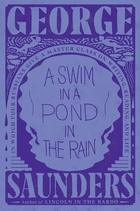 A Swim in the Pond in the Rain—in Which Four Russians Give a Master Class on Writing, Reading, and Life by literary master George Saunders is a most unusual and wonderful book. Although Saunders is a long-admired and favorite author, I initially resisted his newest book based on the title. I thought I was not interested in reading Russian short stories by masters such as Chekhov, Tolstoy, Turgenev, and Gogol—and certainly not in analyzing them. And I was wrong! After convincing recommendations by two book people I trust, Walter Parker and Toby Gordon, I succumbed and was immediately hooked. On the very first page, Saunders had my admiration as he talks glowingly about his students (six to seven of them-- selected from six to seven hundred applicants-- and he dedicates his book to them): “They arrive already wonderful. . . . At this level, good writing is assumed; the goal is to help them acquire the technical means to become defiantly and joyfully themselves.” (p. 3) To that end, Saunders invites us inside his longtime, Syracuse University course on the 19th-century short story. He enlightens us as we are side by side with him, sometimes line by line and page by page, as we study and analyze what the story writer has done as we ponder such questions as: What makes a reader keep reading? When does a story become a story? How did the story writer achieve the effect he did? What is truth? Privy to Saunders’ close reading and brilliant thinking—along with his students’, we are given the opportunity to become more discerning and thoughtful readers and writers ourselves.
A Swim in the Pond in the Rain—in Which Four Russians Give a Master Class on Writing, Reading, and Life by literary master George Saunders is a most unusual and wonderful book. Although Saunders is a long-admired and favorite author, I initially resisted his newest book based on the title. I thought I was not interested in reading Russian short stories by masters such as Chekhov, Tolstoy, Turgenev, and Gogol—and certainly not in analyzing them. And I was wrong! After convincing recommendations by two book people I trust, Walter Parker and Toby Gordon, I succumbed and was immediately hooked. On the very first page, Saunders had my admiration as he talks glowingly about his students (six to seven of them-- selected from six to seven hundred applicants-- and he dedicates his book to them): “They arrive already wonderful. . . . At this level, good writing is assumed; the goal is to help them acquire the technical means to become defiantly and joyfully themselves.” (p. 3) To that end, Saunders invites us inside his longtime, Syracuse University course on the 19th-century short story. He enlightens us as we are side by side with him, sometimes line by line and page by page, as we study and analyze what the story writer has done as we ponder such questions as: What makes a reader keep reading? When does a story become a story? How did the story writer achieve the effect he did? What is truth? Privy to Saunders’ close reading and brilliant thinking—along with his students’, we are given the opportunity to become more discerning and thoughtful readers and writers ourselves.
Set your worries aside. If like me, you are unfamiliar with Russian short stories, Saunders’ multiple pages of fascinating commentary that accompany each story’s translation show how great fiction works, for example, how carefully observing even one person in a story—inner thoughts, actions, life events, physical appearance, telling details—can illuminate us on the human condition. Some of Saunders’ sage writing advice to the reader/writer, which I especially appreciated as a teacher and a writer include: “We know that no matter how the Russians did it, we’re each going to have to find our own way.” (p. 110), and “Revising like this is a way of listening to the story and of having faith in it; it wants to be its best self, and if you’re patient with it, in time, it will be. (p. 113.) “That’s the kind of story I want to write, the kind that stops being writing and starts being life.” (p. 223) “The difference between a great writer and a good one (or a good one and a bad one) is in the quality of the instantaneous decisions she makes as she works.” (p. 345) “The closest thing to a method I have to offer is this: go forth and do what you please.” (p. 386) If only we had the courage, support and wherewithal to do this for ourselves and our students. Don’t miss the interview with Saunders on writing wisdom and writing tips (with thanks to Walter Parker for sharing it); it’s pure gold for anyone looking to become an inspired, creative writer.
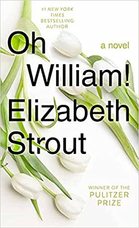 Elizabeth Strout’s novel Oh William! is the latest gem in her books about Lucy Barton, a writer, a daughter, a mother, and twice married woman who is also the narrating voice in this story. In her earlier, related books Anything Is Possible and My Name Is Lucy Barton, we come to know about Lucy’s traumatic, destitute childhood and her later success as a writer. In Oh William! Lucy’s first husband William re-enters her life at a time when she is lonely and grieving the loss of her beloved husband David. She agrees to William’s request to accompany him on a trip to Maine to help uncover a painful family secret. As they get reacquainted and grow more comfortable with each other, past secrets, insecurities, and complexities of human behavior are gingerly revealed. In her trademark spare and luminous writing, Strout employs everyday speech and plain language to communicate the awkwardness, joy, sorrow, mystery of marriage, the human condition, and life in general. “This is the way of life,” Lucy says: “the many things we do not know until it is too late.” For much more about this book, see the excellent NPR book review and The Washington Post review. Full of heart, tenderness, and emotional truths, Oh William! is a generous gift to the reader. Don’t worry if you haven’t read the first two Lucy Barton books; Lucy provides any missing information you need to understand the latest chapters of her life.
Elizabeth Strout’s novel Oh William! is the latest gem in her books about Lucy Barton, a writer, a daughter, a mother, and twice married woman who is also the narrating voice in this story. In her earlier, related books Anything Is Possible and My Name Is Lucy Barton, we come to know about Lucy’s traumatic, destitute childhood and her later success as a writer. In Oh William! Lucy’s first husband William re-enters her life at a time when she is lonely and grieving the loss of her beloved husband David. She agrees to William’s request to accompany him on a trip to Maine to help uncover a painful family secret. As they get reacquainted and grow more comfortable with each other, past secrets, insecurities, and complexities of human behavior are gingerly revealed. In her trademark spare and luminous writing, Strout employs everyday speech and plain language to communicate the awkwardness, joy, sorrow, mystery of marriage, the human condition, and life in general. “This is the way of life,” Lucy says: “the many things we do not know until it is too late.” For much more about this book, see the excellent NPR book review and The Washington Post review. Full of heart, tenderness, and emotional truths, Oh William! is a generous gift to the reader. Don’t worry if you haven’t read the first two Lucy Barton books; Lucy provides any missing information you need to understand the latest chapters of her life.
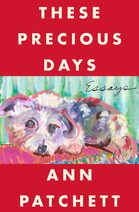 These Precious Days is a marvelous, beautifully written book, one of Ann Patchett’s finest. The book is a collection of about twenty, personal essays. The title essay, “These Precious Days: This is How the Story Ends”, is the story of an extraordinary, late-in-life friendship. It first appeared in Harper’s Magazine in January 2021, which is where I first read it and then sent it to everyone I knew who I thought might appreciate it. The story is that good and that impactful. Patchett’s essays feel like a celebration and reckoning with life. Her writing about family happenings, not having children by choice, adored husband Karl, vegetarian cooking, opening an independent bookstore, enchantment with Kate DiCamillo’s children’s books, and so much more grab at the heart strings. We get to know Ann Patchett and to admire her—for her choices, generosity, kindheartedness, and honesty. Of Patchett’s writing style, Alex Witchel in The New York Times Book Review writes: “Patchett’s heart, smarts and 40 years of craft create an economy that delivers her perfectly understated stories emotionally whole. Her writing style is most gloriously her own.” I love this book; it’s an uplifting and inspiring read for the New Year or any time of year.
These Precious Days is a marvelous, beautifully written book, one of Ann Patchett’s finest. The book is a collection of about twenty, personal essays. The title essay, “These Precious Days: This is How the Story Ends”, is the story of an extraordinary, late-in-life friendship. It first appeared in Harper’s Magazine in January 2021, which is where I first read it and then sent it to everyone I knew who I thought might appreciate it. The story is that good and that impactful. Patchett’s essays feel like a celebration and reckoning with life. Her writing about family happenings, not having children by choice, adored husband Karl, vegetarian cooking, opening an independent bookstore, enchantment with Kate DiCamillo’s children’s books, and so much more grab at the heart strings. We get to know Ann Patchett and to admire her—for her choices, generosity, kindheartedness, and honesty. Of Patchett’s writing style, Alex Witchel in The New York Times Book Review writes: “Patchett’s heart, smarts and 40 years of craft create an economy that delivers her perfectly understated stories emotionally whole. Her writing style is most gloriously her own.” I love this book; it’s an uplifting and inspiring read for the New Year or any time of year.
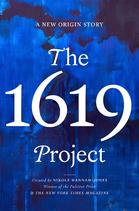 Finally, even though I have only read the Preface and first chapter of The 1619 Project: A New Origin Story (2021) created by Nikole Hannah Jones and The New York Times Magazine, this scholarly and literary work from many contributors comes at such a significant and fraught time in our history that it begs to be mentioned now. It is a long book, about 600 pages, comprised of essays, poems, works of fiction, photographs, and much more--all related to the experiences and legacy of formerly enslaved people in America. The book requires a slow and thoughtful read. (I will include a full accounting in my next “What I’m Reading” posting.) As is my pattern with new books, I read the Acknowledgments first. As a writer, I know a book is never the work of just one person, and I am curious to know about the supporting cast. Here is where I learned that Nikole Hannah had an educator who changed her life. “You fed my intellect, encouraged my skepticism, and taught me it is okay to push the boundaries of other people’s expectations of you. I wish that every student could have a Mr. Dial in her life. Thank you.” (p. 489) In the Preface, we learn more. Nikole Hannah Jones relates that when she was a high school sophomore, Ray Dahl, the only Black male teacher she ever had, taught the “The African American Experience,” the one semester, elective course she was taking. She writes, “At school, I searched desperately to see myself in the American story we were taught, to see my humanity—our humanity reflected back to me.” (xviii) One day Ray Dahl handed her Before the Mayflower by historian and journalist Lerone Bennett, where she learned a fuller history of Black America, including the 1619 origin story—learning about it for the first time. That new knowledge greatly influenced the trajectory of her life. For a deeply informative, expansive exploration, and review of The 1619 Project: A New Origin Story see A Nation’s Legacy in The New York Times Book Review from November 2021. Also, share with students the outstanding, lyrical picture book, The 1619 Project: Born on the Water, for readers of all ages on the history and consequences of slavery.
Finally, even though I have only read the Preface and first chapter of The 1619 Project: A New Origin Story (2021) created by Nikole Hannah Jones and The New York Times Magazine, this scholarly and literary work from many contributors comes at such a significant and fraught time in our history that it begs to be mentioned now. It is a long book, about 600 pages, comprised of essays, poems, works of fiction, photographs, and much more--all related to the experiences and legacy of formerly enslaved people in America. The book requires a slow and thoughtful read. (I will include a full accounting in my next “What I’m Reading” posting.) As is my pattern with new books, I read the Acknowledgments first. As a writer, I know a book is never the work of just one person, and I am curious to know about the supporting cast. Here is where I learned that Nikole Hannah had an educator who changed her life. “You fed my intellect, encouraged my skepticism, and taught me it is okay to push the boundaries of other people’s expectations of you. I wish that every student could have a Mr. Dial in her life. Thank you.” (p. 489) In the Preface, we learn more. Nikole Hannah Jones relates that when she was a high school sophomore, Ray Dahl, the only Black male teacher she ever had, taught the “The African American Experience,” the one semester, elective course she was taking. She writes, “At school, I searched desperately to see myself in the American story we were taught, to see my humanity—our humanity reflected back to me.” (xviii) One day Ray Dahl handed her Before the Mayflower by historian and journalist Lerone Bennett, where she learned a fuller history of Black America, including the 1619 origin story—learning about it for the first time. That new knowledge greatly influenced the trajectory of her life. For a deeply informative, expansive exploration, and review of The 1619 Project: A New Origin Story see A Nation’s Legacy in The New York Times Book Review from November 2021. Also, share with students the outstanding, lyrical picture book, The 1619 Project: Born on the Water, for readers of all ages on the history and consequences of slavery.
Commentary: The Impact of a Lovely, Local Independent Book Store—and More
The new bookstore in our small community has literally changed my life. It has become my place of tranquility and happiness amidst pandemic anxiety, dreary weather, and uncertain times. I visit the shop almost weekly. Although tiny, it is wonderfully organized, and somehow manages to have almost everything I am looking for. If not, the bookseller, who is most often the general manager, cheerfully orders what I am looking for and gives me a call as soon as the book or books arrive. Other bookstore amenities include complimentary gift wrapping; weekly newsletters with new releases, best sellers, and recommendations; a monthly book club; story times for kids; and other public events. Having this magical place so close by is a joy.
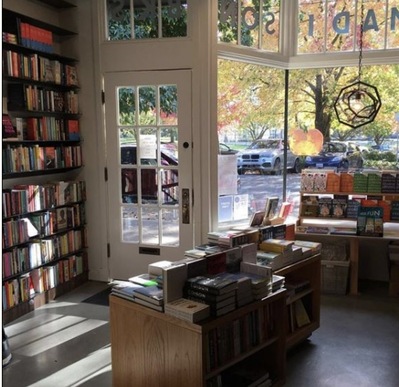
Madison Books, located in the Seattle area, is a member of Bookshop.org a worldwide, online bookstore with a mission to financially support local, independent bookstores: “We believe that bookstores are essential to a healthy culture and we are a benefit corporation, a company dedicated to the common good.” I happily support this mission. In fact, I now order almost all my books through my local, independent bookstore and delight in knowing some of the money from sales gets funneled back into the community in the form of rent, wages, and so forth instead of going into the pockets of distant shareholders. The 400-square foot space that Madison Books has occupied since 2019 had been a vacant blight for about 10 years, plus our neighborhood had been without a bookstore since 2005. Not surprisingly, community members have been overwhelmingly thrilled to welcome this dazzling newcomer. For more on the origins of the bookshop and its general manager, see this news article.
Part of the allure of visiting the bookstore has been chatting with James Crossley, the general manager. He is astonishingly well read and thoughtful about books. He is usually the one in the store when I drop in, so we’ve gotten to know each other book wise. We book talk regularly, on the fly, while I’m buying and paying for books. Recently, I asked him for a book recommendation: “James, I’ve bought a lot of books here, so you have a good feel for what I like. Can you recommend a book to me I might not choose for myself?” Without hesitation he recommended A Ghost in the Throat by Doireann Ní Ghríofa , a strange but wonderful and unforgettable book that blends all of the following while moving back and forth between the present and the faraway past: nonfiction, biography, memoir, fiction, poetry, and prose. I had read a bit about the book and saw it on various “Best Books of 2021” lists-- including “Best Irish Book of 2021”--but never got past the title, which I found off-putting, even a bit creepy.
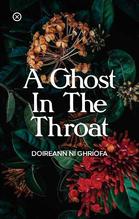 As well, the subject matter of the book—a young woman (the author) who is obsessed with reading and interpreting a long, 18th century Irish poem by a noblewoman/poet while going about the everydayness of her life in the 21st century--did not initially draw me in. However, I trusted James’ judgment—including his endorsement on the back cover of the book—forged ahead and was greatly rewarded. And what a book! I’ve never read anything quite like it. It’s beautifully crafted in an original format and storyline that seeks to connect two women’s lives—the author’s and the 18th century poet-- across centuries. By providing poetic space and giving voice to ordinary goings-on--caring for her four small children, keeping “to do” lists, cleaning the house, balancing motherhood and marriage--the author/poet celebrates acts of daily living. People can work hard and suffer a lot but manage to keep going and thrive. Profound thoughts can occur while doing daily work. Doireann Ní Ghríofa is determined to understand, honor, and bring to life the author of the great poem “Caoineadh Airt Uí Laoghaire” by Eibhlín Dubh Ní Chonaill, while figuring out the meaning of her own life. The end of the book includes Ghríofa’s translation of the long and haunting poem.
As well, the subject matter of the book—a young woman (the author) who is obsessed with reading and interpreting a long, 18th century Irish poem by a noblewoman/poet while going about the everydayness of her life in the 21st century--did not initially draw me in. However, I trusted James’ judgment—including his endorsement on the back cover of the book—forged ahead and was greatly rewarded. And what a book! I’ve never read anything quite like it. It’s beautifully crafted in an original format and storyline that seeks to connect two women’s lives—the author’s and the 18th century poet-- across centuries. By providing poetic space and giving voice to ordinary goings-on--caring for her four small children, keeping “to do” lists, cleaning the house, balancing motherhood and marriage--the author/poet celebrates acts of daily living. People can work hard and suffer a lot but manage to keep going and thrive. Profound thoughts can occur while doing daily work. Doireann Ní Ghríofa is determined to understand, honor, and bring to life the author of the great poem “Caoineadh Airt Uí Laoghaire” by Eibhlín Dubh Ní Chonaill, while figuring out the meaning of her own life. The end of the book includes Ghríofa’s translation of the long and haunting poem.
Full disclosure: I am unable to do this brilliant book justice; it defies classification and easy analysis. For three, excellent reviews and clear insights on A Ghost in the Throat, see The Guardian with this telling line: “In snatched moments of solitude – invariably accompanied by a whirring breast pump – she would study her tatty photocopy of the poem, ‘inviting the voice of another woman to haunt my throat a while’ ”. See also the book reviews from Kirkus Reviews and The New York Times. For further enlightenment about the author and the book, see this video interview, moderated by James Crossley, with author and poet Doireann Ní Ghríofa and acclaimed Maine poet Éireann Lorsung.
It was through that interview that James and I first learned about a book of fiction both poets/writers were raving about: The Archive of Alternative Endings by Lindsey Drager. Trusting their recommendation (and later, James’ as well), I dispensed with my initial trepidation (a title, again) and was treated to an amazing book that is, once again, difficult to categorize but fascinating to read. Set aside any normal storybook expectations and imagine, if you will, the Hansel and Greta fairy tale linked to Halley’s comet and the AIDS crisis—and the way stories and happenings shift, change, and intersect through different time periods over centuries. I know, it sounds weird and head spinning, but it works. I won’t easily forget this book, its important implications for living, and the many ways people and happenings can be interpreted—for ill and for good—in the real world and in the world of fairy tales. See/hear excellent, clarifying National Public Radio (NPR) review.
As you might expect, James Crossley was delighted I loved his book recommendation of A Ghost in the Throat. “This is why I love this job. As a bookseller, I get to introduce readers to books they might not have found on their own.” Thank you, James, for helping to make securing and reading books a necessary pleasure, a nourishing indulgence, and a soul saver. My heart and my bookshelves also thank you. Both are better informed, balanced, and hopeful. Our students deserve no less.
To bring similar magic and books to students typically denied book access and book ownership--due to such factors as poverty, homelessness, and hospitalization-- check out https://www.bringmeabook.org/ and its many offerings for students, teachers, and families. With support from a wide range of partners, Bring Me A Book (BMAB), headed by Executive Director Lois Bridges, helps schools and organizations serve children in under resourced settings. In so doing, students are granted the opportunity to move from book scarcity to book abundance—in school and at home—and to become joyful readers. Bring Me a Book access partners include school and public libraries, First Book, and socially responsible, revenue-sharing, start-up Bookelicious, which allows students to create their own bookmoji (personalized reading avatar)--from a culturally responsive collection of 18,000 books--to suit their reading interests and preferences, to use as an expansive wish list at the public library, and/or for choosing several books to own. Also, to be celebrated, BMAB provides the materials and guidance for students and their families to assemble free-standing Book Cubbies for a child’s home library. Having designated shelves for self-selected books is as important for honoring children as readers as it is for us adults as readers. Those well-placed, carefully chosen books improve the quality of our lives; they make the magic of reading a daily and visible reality. In these uncertain times, we need all the magic and joy we can get.